One billion hours of video.
That’s how much content is viewed each and every day on YouTube!
That translates to 46,000 years of content annually.
Another amazing thing about YouTube is the amount of time users spend on it.
Believe it or not, the average YouTube session is 40 minutes.
That dwarfs the amount of time people spend on Instagram and Twitter.
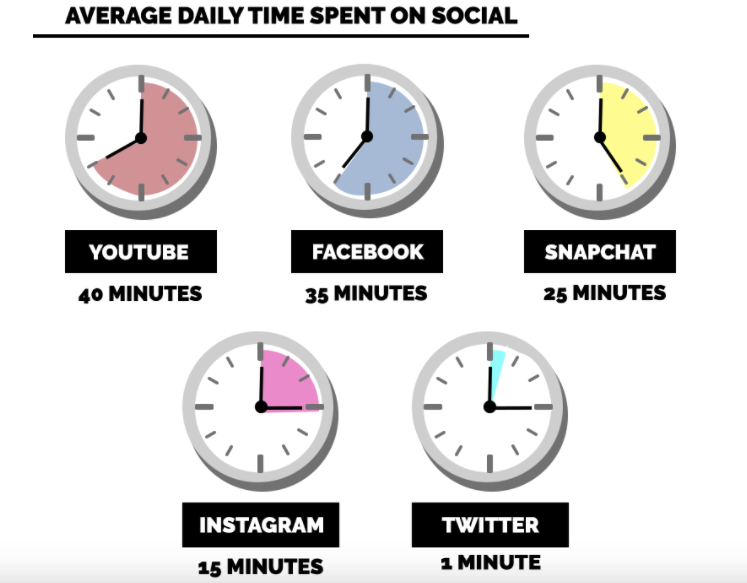
Talk about engagement!
Here are a few other ridiculous stats that demonstrate YouTube’s potency:
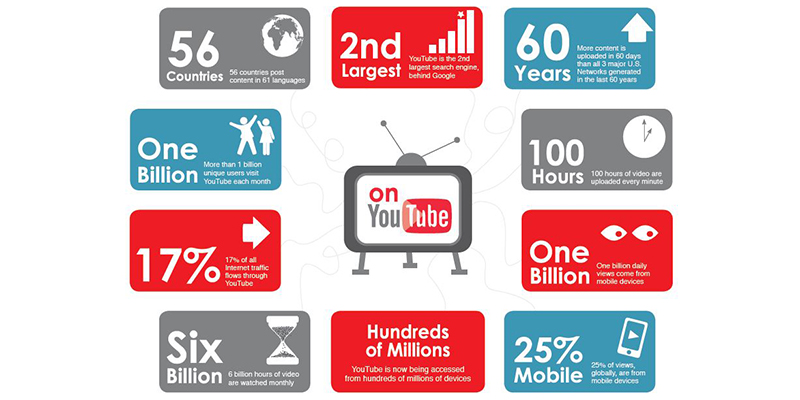
This is a huge opportunity for content marketers to tap into.
But just setting up a YouTube account, recording some videos and uploading them isn’t enough to get people to subscribe and follow you on YouTube.
You need some hard-hitting strategies that will draw people in and convince them that you are somebody to watch and follow.
Let me show you 13 strategies that will help you boost your YouTube subscriber count and improve your YouTube brand today.
1. Monitor “attention score” to measure good storytelling
YouTube executive Bing Chen says, “Another thing that cannot be replaced is good storytelling. We really recommend you go into your dashboard and look at your attention score.”
What exactly is your attention score? This shows you the level of attention and the length of time people spend watching your videos.
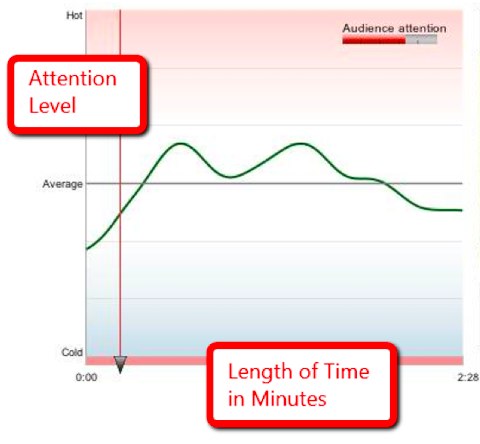
If your score is a solid red, then you are doing pretty well. But if it is falling off at a particular area, you might want to change that. You can also use a service to promote your YouTube channel for you.
There are two types of YouTube content: entertainment and information.
Entertainment videos pull people in with good headlines or enticing thumbnails, so the attention level is high at the beginning but drops off towards the end.
Here’s what makes a great entertaining video:
- Five-second rule – A great entertaining video must grab people in the first five seconds. You can use questions or put yourself into an unusual situation. And don’t forget the conflict. People have to get a feeling of suspense immediately.
- Storytelling – Bing Chen says this is essential. Learn the tricks of weaving a good story so that people will hang with you through the duration of the video. You can use gimmick or conflict to achieve that.
- Short – Entertaining videos can’t be too long. Between one and three minutes is ideal. This is where looking at your attention score is critical. Where are people dropping off? Is that the upper reaches of attention span?
The other type of video is an informative video. This is your tutorials and how-to and do-it-yourself clips. The thing about these types of videos is that their attention scores will be just the opposite of an entertaining video.
- Early attention score is low – Most of the traffic drops off early. People decide quickly whether they will learn what they want to learn from a video.
- Late attention score is high – Those who stay past the two or three-minute mark will typically stay for the entire video.
- Steps – Great informative videos pull people along by giving them systematic steps to accomplish a particular task. In fact, people may tend to pause the video and write notes or actually perform the task. Think about how you would learn to fold a paper airplane or fix a sink.
- Length – It doesn’t matter how long your informative video is as long as you are giving people the answers they need.
2. Use annotations
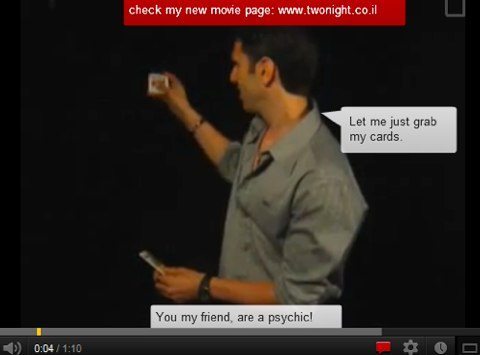
YouTube annotations are the notes on your videos. You can use them to help you increase your audience by following these techniques:
- Call to action – Create a sticky note suggesting people subscribe to your channel.
- Spotlight annotation – This will allow you to create a clickable annotation on the video itself. Drive people to a landing or product page.
- Link to other videos – Annotations will also allow you to link to related videos (whether they are yours or not).
You control where the annotations appear on the video. You also control when they appear and disappear.
These are shown on your video any time someone plays it, but the viewer can go into the video player menu screen and turn them off.
3. Five steps to planning a good video
There is a lot of planning behind a good video. Let’s look at five elements of good video planning:
- Keyword research – You won’t get traffic, let alone high-quality traffic, if you don’t do your research with keywords. Google’s keyword tool will show you what’s hot and has the highest volume. Avoid the long-tail keywords.
- Transcript – After you’ve recorded the video, grab the transcript and upload it to YouTube. This will give Google more context to help index it and give you an additional number of words to help people searching.
- Social Media Engagement – Work your social networks. Share the video two or three times a week on Facebook, Twitter and Google+ each. The more shares you can get, the more your video will rise in the rankings.
- Your Blog – After about a week, embed the video on your site. Then you can go through the process of sharing it again.
So, those are the basics of creating and sharing a good video. Let’s look at some other ways to share it.
4. Add a YouTube widget to your blog
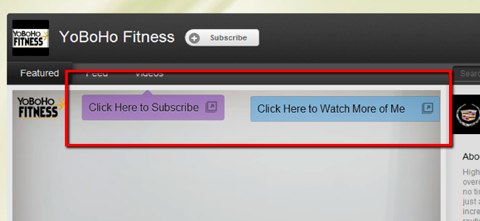
You can drive traffic to your videos if you have a blog that gets a lot of traffic by using a widget. Here are the steps you need to take:
- Embed your videos on your blog – This way you don’t drive traffic away from your blog but keep all the visitors engaged on your site. If your viewers are watching your video on YouTube, there is a greater chance of them being distracted by other videos.
- Use the Subscription Widget – Ask your blog visitors to sign up for your YouTube channel from the sidebar with this widget. It’s pretty simple to install.
- Call-to-action graphic – You can even include two call-to-action graphics that will display while the video is playing (similar to the image above). The “Click Here to Subscribe” button will bring your visitor to a confirm page, and the “Click Here to Watch More of Me” will take them to more videos. You control the words behind these messages.
5. Add featured channels
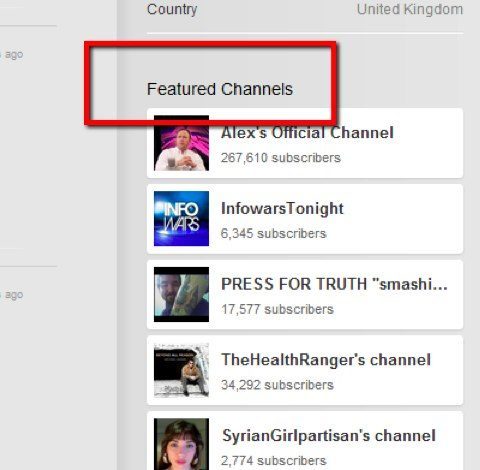
You can also grow your audience by partnering with other content creators on YouTube. You can find this option on your YouTube channel page.
It’s pretty easy to do. On your channel:
- Click Modules > Other channels > Save changes (This will make “Other Features” available on your channel.)
- Add a channel or channels and save.
Be sure to choose content creators who are similar to your industry and whom you think your audience will find beneficial.
Once you’ve found other relevant YouTube content creators, add them to the “Featured Channels” function.
Eventually, you’ll get other YouTube creators sending you traffic because they will choose you as a “Featured Channel.”
6. Create personalized videos
Did you know that Old Spice created over 162 two-minute videos over and above the original “Smell Like a Man” video? Those videos took over two days to record, but the critical thing about them is that they were personalized to people like Kevin Rose, Demi Moore and Alyssa Milano.
The thing is each video took about seven minutes to record. The lesson is that quality videos are super easy to create. And the list of equipment you need is short. Check it out:
- Lighting – You can get a set of $200 lights at Cowboy Studio that will deliver great natural lighting.
- Camera – Nothing fancy here, just your laptop camera or even your phone.
- Microphone – Get a great USB microphone for $100.
7. Engage with inquisitiveness
Another thing that Bing Chen said was that building a solid YouTube brand and audience involved community engagement.
But this isn’t just about replying to comments. It’s so much more. Let me show you:
- Ask questions – Dig into the lives of your commenters. Ask them why they liked the videos and what other content they would like to see.
- Embrace other YouTubers – It just takes 15 minutes a day, but watch a few videos of other producers, like them and comment. Consider subscribing to a few quality videos too. Also, consider creating videos in which you showcase three or four great YouTubers you think your audience should follow, kind of like #followFriday on Twitter.
- Encourage video replies – When asking for ideas for future videos, allow people to create videos replies. But don’t stop there. Make them reply by using your brand. For example, Michael Buckley asks for readers’ questions, but they have to start with, “Dear Buck,” which reinforces his brand.
The rule of community engagement is simply to give, and you will get in return!
8. Come up with a unique angle
One of the most popular channels of all time is Epic Rap Battles of History (ERB).
They’ve featured rap battles that range all the way from Steve Jobs vs. Bill Gates:

to Mr. T vs. Mr. Rogers:

It’s pretty hilarious.
ERB has completely killed it and has a massive following.
They had well over 14 million subscribers as of mid-2017.

I’m not saying you have to be as original as ERB, but you definitely need a unique angle.
To decide on an angle, you have to first identify your core audience.
What kind of content would appeal to them?
Would they go for humor and sarcasm?
A lot of the top channels implement humor to some extent.
YouTube is also a place where people openly embrace their weirdness, so it’s generally okay to be a little out there.
Or should you be professional and go for an educational angle?
It depends on your demographic and its collective taste.
I recommend doing some brainstorming to decide on a basic direction to take.
Of course, this will evolve organically over time, but you’ll need to establish a core identity and preferably one that stands out.
Also keep in mind that most people use YouTube for one of two reasons.
They either want to be entertained or informed, and in some cases both.
Make sure you have a mission and a clear idea of the direction you’re going to take right from the start.
9. Create a killer “home video”
There’s a path that most YouTube users take when learning about a brand or channel.
They’ll first land on an individual video.
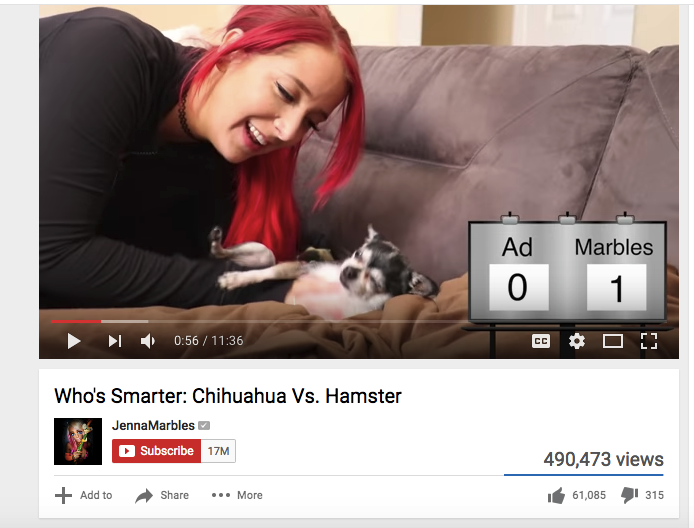
They’ll watch it, and if they like it enough to want to learn more about you, they’ll click on the link to your home profile.
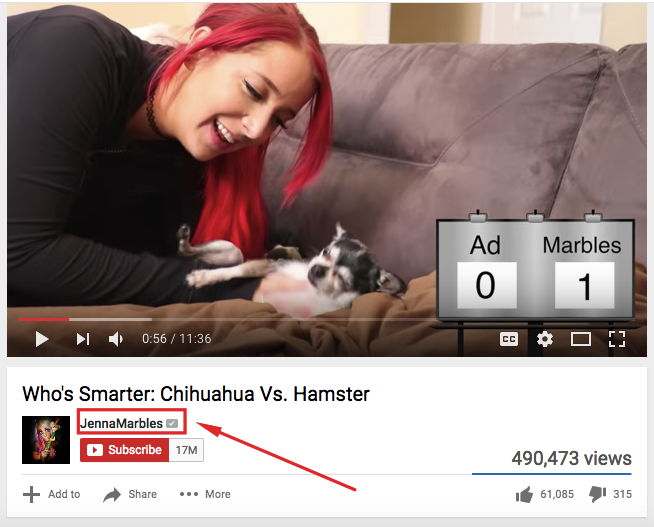
Your home video will automatically play there.
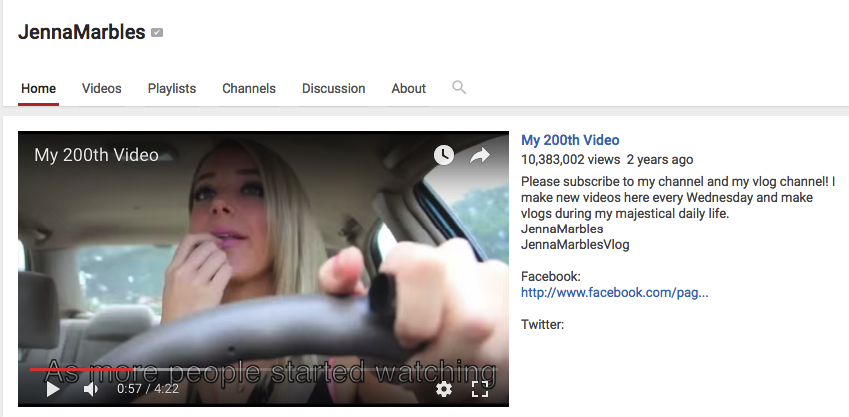
This will basically make you or break you in terms of gaining subscribers.
Either they’ll be compelled to subscribe to your channel, or they’ll head elsewhere.
So, you need to completely crush it with your home video.
More specifically, it needs to encapsulate what your brand and channel are all about.
There are a few ways to approach this.
You could:
- create a video specifically for your homepage, describing your channel and telling viewers what they can expect
- feature one of your top videos that captures the essence of your brand/channel
- create a compilation of the top highlights of previous videos
Whatever approach you take, just be sure you connect the dots for first-time viewers so they know what to expect if they subscribe.
10. Make full use of the About section
Every YouTube channel has an About section that explains the concept of the channel.
Many first-time viewers will check this out to learn more about you.
The information you include in this section will influence whether or not they choose to subscribe.
Don’t haphazardly or carelessly fill out this section.
You want to explain the details and highlight any points potential subscribers should know.
Here’s a good example of a rock solid About section from Fine Brothers Entertainment:
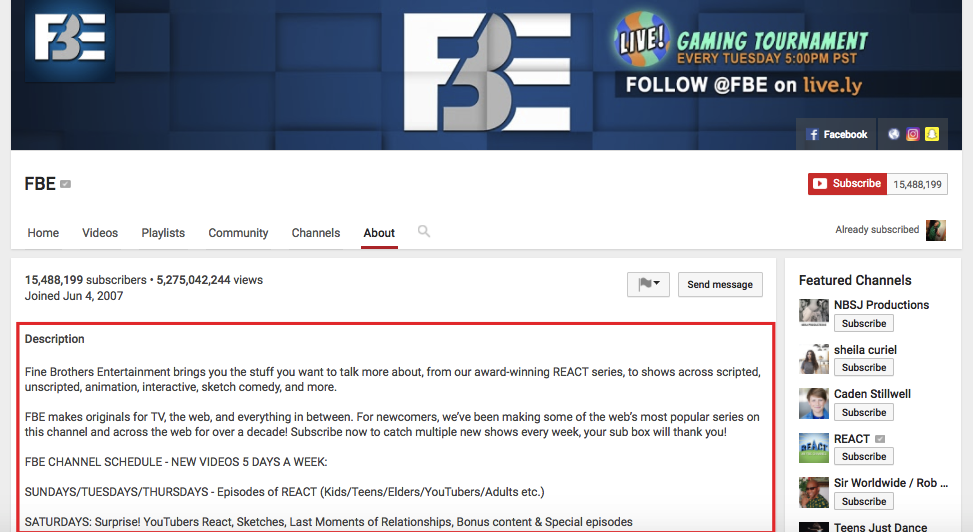
Notice that it gives a clear, succinct description and also mentions the posting schedule.
Here’s another good example from The Needle Drop, one of the most popular music review channels:
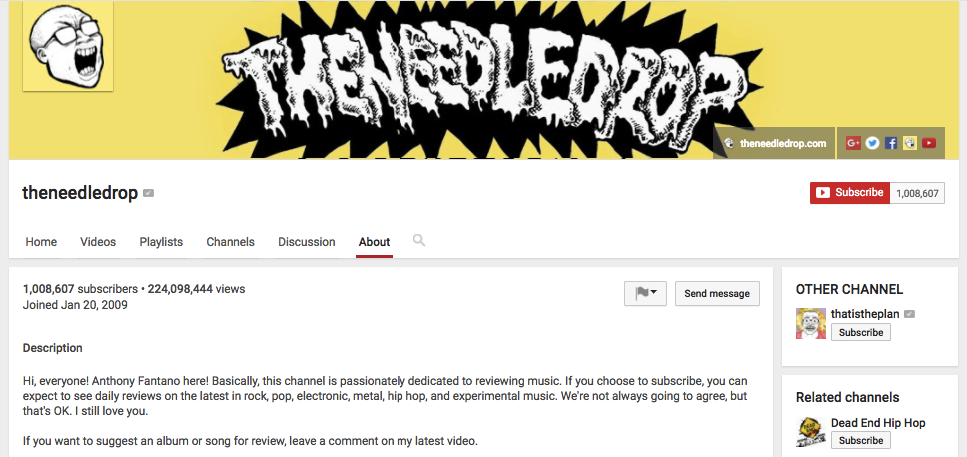
This is yet another opportunity to build a homogeneous brand identity and pique the interest of those unfamiliar with you.
Don’t overlook the About section.
11. Create consistency
“It takes five to seven impressions for someone to remember a brand.”
In order to make your brand both recognizable and memorable, it’s super important to have consistency on your channel.
There are two main ways to accomplish this.
First, your channel should feature recurring characters and themes.
You want to become familiar to your audience to build connections with them over time.
Second, you should strive to stick with a consistent posting schedule.
In order to keep your audience interested and dialed in, you should give them a rough idea of when they can expect new content.
I know I get a little irked and lose interest in channels that go MIA all of a sudden.
It’s generally considered best practice to upload at least one new video a week.
However, two or three videos is even better.
I find the one to three video mark tends to be ideal.
It’s the sweet spot that keeps subscribers interested without fatiguing them with excessive content.
In terms of the best time to post, there’s an article from Tube Filter that offers some good advice on this.
According to their research, these are the best hours to post a video each day:

There’s also evidence suggesting viewership begins rising on Thursday and spikes on Saturday.
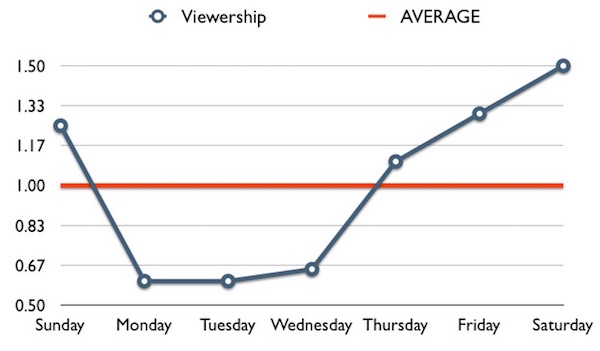
And this makes sense if you think about it.
Unlike most other social networks, like Facebook, Twitter and Instagram, where you can casually scroll through your feed with minimal time investment, YouTube requires a larger commitment, where users often view content in larger blocks.
This makes the weekend the ideal time for viewing.
Plus, people can be stealth about checking most of their social sites at work, but YouTube is trickier.
Usually, they’ll need to wait until they’re off work to indulge.
Keep this in mind when establishing a posting schedule for your videos.
12. Make live video part of your repertoire
Live streaming is a fairly new concept on YouTube.
But it’s starting to spread like wildfire.
According to Mediakix, “YouTube Live video views have grown by 80% and livestreams increased by 130% between 2015 and 2016.”
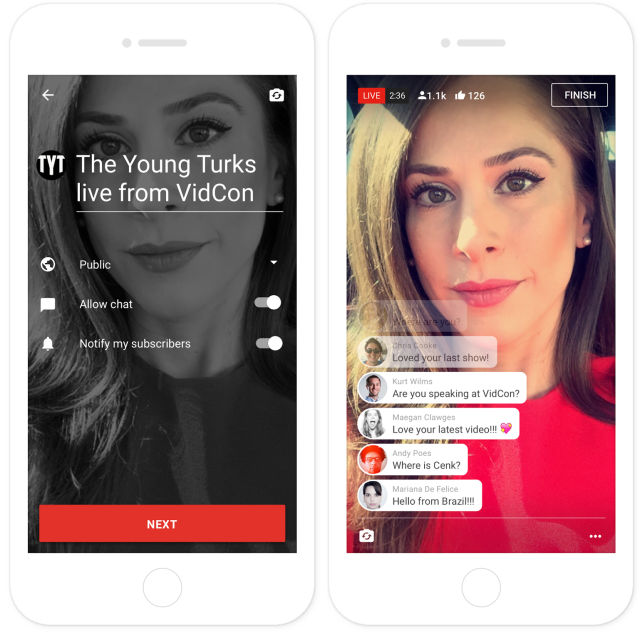
And here’s the thing about live video.
It’s absolutely perfect for brand building.
There’s a certain closeness viewers experience with brands through live streaming. There’s an intimate vibe to it.
You can even answer questions and respond to comments in real time and interact with your audience in a way that’s not possible with any other medium.
Research from Livestream also found that
live video is more appealing to brand audiences: 80% would rather watch live video from a brand than read a blog, and 82% prefer live video from a brand to social posts.
This is definitely something to experiment with if you haven’t done so already.
However, there is one caveat.
You must have at least 1,000 subscribers to be eligible for live video.
But this number has actually dropped dramatically, considering the minimum number was 10,000 earlier in 2017.
13. Collaborate with relevant YouTubers
What’s one of the quickest ways to crank up the exposure of your blog/website and bring in an influx of traffic?
One word: guest-posting.
Collaborating with other awesome YouTubers is basically the equivalent of guest-posting via video, which can boost your brand dramatically.
I’ve had success with this strategy.
Take for instance the time I appeared on Tai Lopez’s channel.
That one video generated over 275,000 views:
If you really want to expedite the growth of your YouTube brand, I highly recommend reaching out to relevant YouTubers in your niche.
It’s really easy.
Find a person’s contact information on their About page, and click on “Send message:”
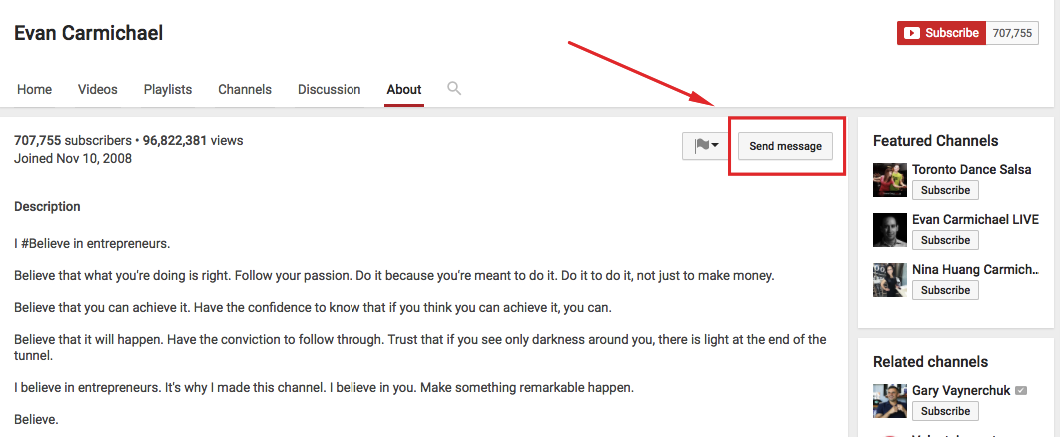
Introduce yourself, tell them how much you like their channel and explain your idea for a collaboration video.
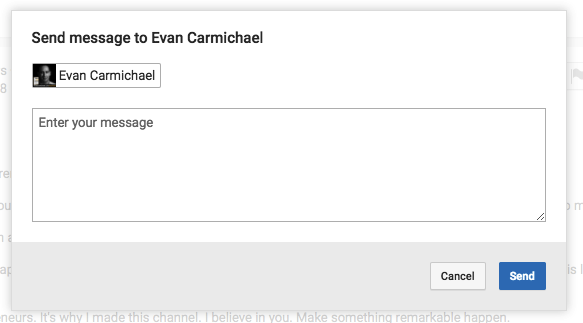
You don’t even need to do the video face to face—you can record footage, interacting remotely through FaceTime, Skype, etc.
This way, you can leverage someone else’s subscriber base to quickly grow your own following.
Conclusion
It’s really hard to beat YouTube as a brand-building platform.
The massive built-in audience combined with the intimacy that comes with video is the perfect recipe for building your brand from the ground up.
Not only can you build an audience, you can build a unique, successful brand your competitors won’t be able to replicate.
The real magic behind growing your YouTube audience is being consistent.
All of the superstar YouTubers share this in common: they’ve committed to a schedule and churn out quality, authentic videos according to that schedule.
Some became famous in a matter of days or weeks. For others, it has taken months or longer. But they all stuck to it and eventually succeeded.
So, get out there, start cranking out some videos, measuring success and growing your audience.
If you need some extra encouragement I’ve also created an infographic below that breaks down exactly what you need to do to increase your YouTube engagement by 374%.





